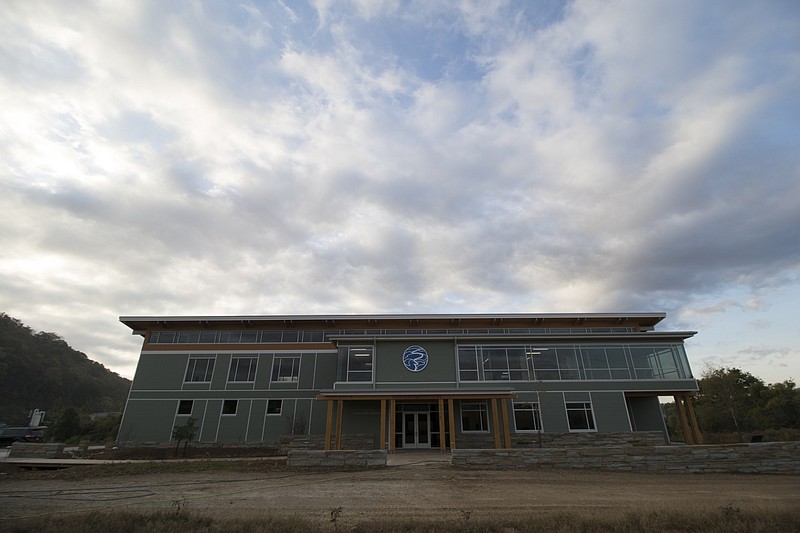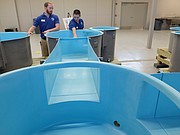If you go
› What: A free, open house of the new facility for local high school science teachers› When: Thursday, Nov. 3, 2-6 p.m.› Where: Tennessee Aquarium Conservation Institute, Baylor School campus
Biologists at the Tennessee Aquarium Conservation Institute carried themselves with a palpable enthusiasm Monday.
It's not every day you get to show off a new 14,000-square-foot home.
Aquarium employees and volunteers got a sneak peak of the institute's new building that formally opens today adjacent to the Baylor School campus.
They were an attentive audience as the institute's conservation experts explained how the aquarium's expanding research operation will be enhanced by the state-of-the-art structure, on the banks of the Tennessee River.
Erin Durant, the institute's new watershed educator, stood in the "flex lab" on the first floor and told visitors how the space will provide opportunities to area high school students with a deep interest in freshwater biology.
"With this new building, we have the opportunity to expand our programs in a way that we never have before," she said.
Upstairs, turtle and salamander specialist Josh Ennen and cave biologist Bernie Kuhajda raved about the space, equipment and ability to collaborate with colleagues provided by the new facility.
In the propagation room, reintroduction specialists Clay Raines and Maxwell Rupp pointed to manufactured streams contained in massive cisterns that will be used to help the institute reintroduce - and simulate conditions for - fish and salamander species that inhabit the Tennessee River.
Raines put it all in perspective.
"Soon," he said, "we will all be under the same roof for the first time in the institute's history."
The $4.5 million structure is a fitting 20-year anniversary present for the institute, which reports to the aquarium's board of trustees. Since 1996, the institute has worked to research and conserve the world-renowned biodiversity of the Tennessee River basin from various locations and facilities.
While the downtown facility will remain the Tennessee Aquarium's public centerpiece, the new building on Baylor's campus provides a central location for its researchers and their partners from around the Southeast to bolster the mission of restoring the region's natural ecosystems and educating the public on conservation.
"One of the things that has made this project so important to the broader conservation community is that the aquarium is an independent nonprofit [organization]," said Andree Herbert, aquarium director of development. "That means we are not allegiant to a university, a state government or a federal agency. That's why people turn to us and ask if we'll help pull everyone together. We have neutral turf, and that really matters in this field."
The conservation institute is not open to the public, aside from monthly tours that require online registration, but its mission is essential to the aquarium's reputation for doing more than just showcasing the region's biodiversity for public view.
"Part of what separates this facility, to me, is that unlike a government agency or a university, we have the voice of the aquarium behind us," Tennessee Aquarium Conservation Institute Director Anna George said. "It will remain the megaphone. It's where we reach 750,000 people a year and can tell these stories of our freshwater animals, why they matter and how we can help protect them."
The building itself is a model of conservation. Project officials aim to have the building designated with Leadership in Energy and Environmental Design Gold certification - the second-highest ranking in the U.S. Green Building Council's certification program.
Plants on the property are "hyperlocal" to the area, and the building strategically channels rainwater into a 6,500-gallon cistern with two filters that purify to the point that it's nearly drinkable. From there, it overflows into a basin and wetland area that channels the water to the river.
"This space is kind of an example for the city of Chattanooga of a stormwater retention area," institute science coordinator Shawna Mitchell said.
Back inside, every work station in the building is bathed with natural light, except for the geographic information systems lab on the second floor, where Sarah Sweat oversees an operation that uses data collected from the field to create detailed mapping of the freshwater aqua life of the region.
"This is the only windowless room in this entire place," Sweat said, "and I designed it that way because GIS is very computer-heavy, and if you have that natural light competing with the computer screen, it can give you a migraine."
But just a few steps away in a common-space work area is a view of the river meandering toward the mountains.
"Working upstairs and looking at the thing we're trying to protect is extremely inspirational and something a lot of scientists and a lot of nonprofits don't always get," George said. "So I feel incredibly lucky that every day I get to be inspired by what I do."
Contact staff writer David Cobb at dcobb@timesfreepress.com or 423-757-6249.

